Electric System:
1. General Introduction:
Electricity (from the New Latin ēlectricus, "amber-like") is a general term that encompasses a variety of phenomena resulting from the presence and flow of electric charge. These include many easily recognizable phenomena, such as lightning and static electricity, but in addition, less familiar concepts, such as the electromagnetic field and electromagnetic induction.
In general usage, the word "electricity" is adequate to refer to a number of physical effects. In scientific usage, however, the term is vague, and these related, but distinct, concepts are better identified by more precise terms, for example:
- Electric charge – a property of some subatomic particles, which determines their electromagnetic interactions. Electrically charged matter is influenced by, and produces, electromagnetic fields.
- Electric current – a movement or flow of electrically charged particles, typically measured in amperes.
- Electric field – an influence produced by an electric charge on other charges in its vicinity.
- Electric potential – the capacity of an electric field to do work on an electric charge, typically measured in volts.
- Electromagnetism – a fundamental interaction between the magnetic field and the presence and motion of an electric charge.
2. Atoms:
Every Mass/Matter is made of Atoms. The Atom has a core made of particles, called Protons and Neutrons. Around this core there is an over layer, called Electrosphere, or simply cloud, where negative Electrons are bound to the nucleus by the electromagnetic force.
An atom containing an equal number of protons and electrons is electrically neutral, otherwise it has a positive or negative charge and is an ion. An atom is classified according to the number of protons and neutrons in its nucleus: the number of protons determines the chemical element, and the number of neutrons determine the isotope of the element. (except in the case of hydrogen-1, which is the only stable nuclide with no neutron).
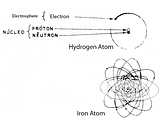
3. Electric Charge:
Protons have specific electric characteristic, called positive charge. Therefore, Electrons are the opposite, they are negative charge. Two equal charges, this being positive or negative, tend to expel from each other. However Two different charges, (1 negative and 1 positive for example) attract each other.
This is simple fact, besides its the basic foundation of electricity. Neutrons don't have electric charge, therefore they are electrically neutral.
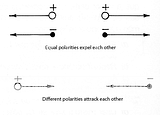
4. Free Electrons:
The Electrons spin freely in different orbits around its Core/Nucleus. In metal materials like copper, aluminium, etc, the outer electrons, or the ones furthest away from its core can transit from a atom to another. Therefore, called free-electrons. When free-electrons move themselves along a wire, we then say that there is an electric current in this wire. The materials that facilitate this process are called conductive materials or electrical conductor.
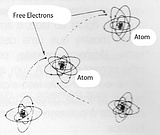
5. Eletromotriz Power (DUNNO HOW TO TRANSLATE THIS, HELP HERE is needed):
On the Positive Terminal of a battery there are excess of protons, and this is why we say that this terminal has a higher potential. On the Negative Terminal, or if you want to call it pole, we have a low potential.
Between two terminals (positive and negative) there is the Eletromotriz power, which is most technically known as difference of potency, voltage or tension. This power is the tendency of free-electrons to be expelled from the NEGATIVE TERMINAL and be attracted to the POSITIVE TERMINAL. (PROTONS have an opposite effect, but they cannot form electric CURRENT because they aren't free
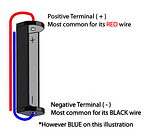
6. Electric Current:
A battery on its own does not produce any electric current, because the air does not allow the passage of the free-electrons. However, if we connect a conductive wire from each terminal of a battery to a light bulb, a electric current of free-electrons will be formed. These free-electrons will be expelled from the NEGATIVE terminal being forced to go to the POSITIVE TERMINAL of the light bulb creating this electrical current. The flow direction of such current is know as an electrical circuit which is a network that has a closed loop, giving a return path for the current. A network is a connection of two or more components, but it may not necessarily be a circuit.
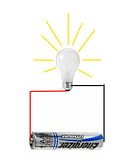
The electrical current is measured in amperes, through a equipment know as ammeter or ampere-meter. On the following picture the ampere-meter shows that a certain light bulb allows a passage of 1A (ONE AMPERE) CURRENT through its circuit, and the motor allows a passage of 3A. This means that the light bulb offers more resistance to the flow of the electrical current.
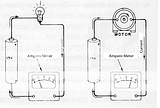
7. Ohm Law:
In electrical circuits, Ohm's law states that the current through a conductor between two points is directly proportional to the potential difference or voltage across the two points, and inversely proportional to the resistance between them. In addition, Electrical resistance (Ohm) is the resistance that a body/mass offer the current passage/flow.
The mathematical equation that describes this relationship is:
***for: volts = amps x resistance
E = Volts
I = Current (Amperes)
R = Resistance
I = E/R or Current = Voltage / Resistance
E = I*R or Voltage = Current * Resistance
R = V/E or Resistance = Voltage / Current
8. Power Supply Connection:
Power supply is everything that gives electricity, like a AA battery, a car battery, a computer PSU, etc. The main ways of connecting two or more power supplies are: in SERIES or IN PARALLEL.
8.1 in SERIES:
It is used to sum up or add tension/voltage of several supplies that can be different from each other. Example:
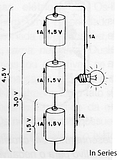
8.2 in PARALLEL:
Is used to increase the capacity of supplying current. All supplies must have the same tension/voltage, if not the lower voltage supplies will consume the current instead of supplying it. Theoretically, power supplies of same voltage/tension contribute equally to the increase of the current. Practically, this rarely occurs, but the final current is the the sum up of each supply's current. For example:

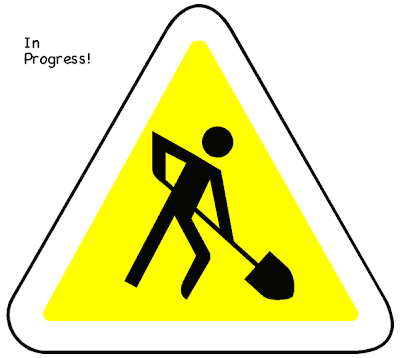
WORK IN PROGRESS, PLEASE FEEL FREE TO COMMENT and NOTIFY ME IF THERE ARE ANY MISTAKES!!!
I will be soon adding more to the list of basics of Electric Systems.

